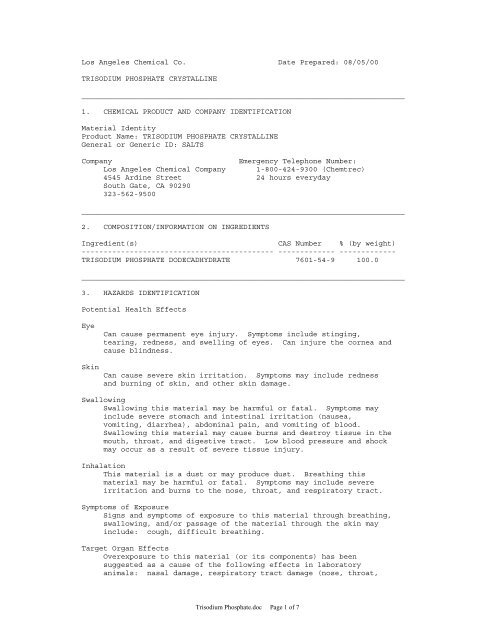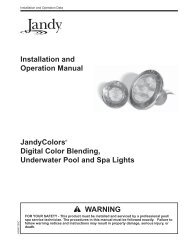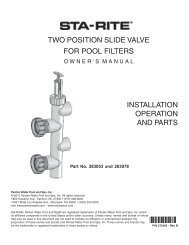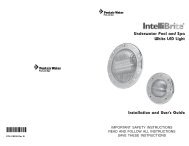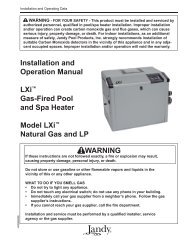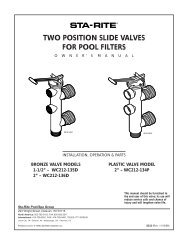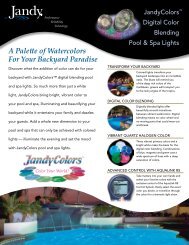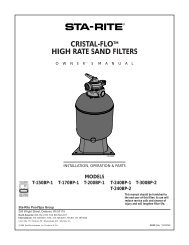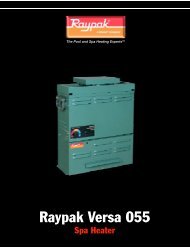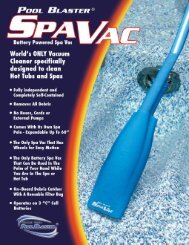Trisodium Phosphate - H2Oco.com
Trisodium Phosphate - H2Oco.com
Trisodium Phosphate - H2Oco.com
Create successful ePaper yourself
Turn your PDF publications into a flip-book with our unique Google optimized e-Paper software.
Los Angeles Chemical Co. Date Prepared: 08/05/00<br />
TRISODIUM PHOSPHATE CRYSTALLINE<br />
__________________________________________________________________________<br />
1. CHEMICAL PRODUCT AND COMPANY IDENTIFICATION<br />
Material Identity<br />
Product Name: TRISODIUM PHOSPHATE CRYSTALLINE<br />
General or Generic ID: SALTS<br />
Company<br />
Emergency Telephone Number:<br />
Los Angeles Chemical Company 1-800-424-9300 (Chemtrec)<br />
4545 Ardine Street 24 hours everyday<br />
South Gate, CA 90290<br />
323-562-9500<br />
__________________________________________________________________________<br />
2. COMPOSITION/INFORMATION ON INGREDIENTS<br />
Ingredient(s) CAS Number % (by weight)<br />
-------------------------------------------- ------------- -------------<br />
TRISODIUM PHOSPHATE DODECADHYDRATE 7601-54-9 100.0<br />
__________________________________________________________________________<br />
3. HAZARDS IDENTIFICATION<br />
Potential Health Effects<br />
Eye<br />
Can cause permanent eye injury. Symptoms include stinging,<br />
tearing, redness, and swelling of eyes. Can injure the cornea and<br />
cause blindness.<br />
Skin<br />
Can cause severe skin irritation. Symptoms may include redness<br />
and burning of skin, and other skin damage.<br />
Swallowing<br />
Swallowing this material may be harmful or fatal. Symptoms may<br />
include severe stomach and intestinal irritation (nausea,<br />
vomiting, diarrhea), abdominal pain, and vomiting of blood.<br />
Swallowing this material may cause burns and destroy tissue in the<br />
mouth, throat, and digestive tract. Low blood pressure and shock<br />
may occur as a result of severe tissue injury.<br />
Inhalation<br />
This material is a dust or may produce dust. Breathing this<br />
material may be harmful or fatal. Symptoms may include severe<br />
irritation and burns to the nose, throat, and respiratory tract.<br />
Symptoms of Exposure<br />
Signs and symptoms of exposure to this material through breathing,<br />
swallowing, and/or passage of the material through the skin may<br />
include: cough, difficult breathing.<br />
Target Organ Effects<br />
Overexposure to this material (or its <strong>com</strong>ponents) has been<br />
suggested as a cause of the following effects in laboratory<br />
animals: nasal damage, respiratory tract damage (nose, throat,<br />
<strong>Trisodium</strong> <strong>Phosphate</strong>.doc Page 1 of 7
and airways), eye damage, lung damage.<br />
Developmental Information<br />
Based on the available information, risk to the fetus from<br />
maternal exposure to this material cannot be assessed.<br />
Cancer Information<br />
Based on the available information, this material cannot be<br />
classified with regard to carcinogenicity. This material is not<br />
listed as a carcinogen by the International Agency for Research on<br />
Cancer, the National Toxicology Program, or the Occupational<br />
Safety and Health Administration.<br />
Other Health Effects<br />
No data<br />
Primary Route(s) of Entry<br />
Inhalation, Skin contact, Eye contact.<br />
__________________________________________________________________________<br />
4. FIRST AID MEASURES<br />
Eyes<br />
Skin<br />
If material gets into the eyes, immediately flush eyes gently with<br />
water for at least 15 minutes while holding eyelids apart. If<br />
symptoms develop as a result of vapor exposure, immediately move<br />
individual away from exposure and into fresh air before flushing<br />
as re<strong>com</strong>mended above. Seek immediate medical attention.<br />
Remove contaminated clothing. Flush exposed area with large<br />
amounts of water. If skin is damaged, seek immediate medical<br />
attention. If skin is not damaged and symptoms persist, seek<br />
medical attention. Launder clothing before reuse.<br />
Swallowing<br />
Seek immediate medical attention. Do not induce vomiting.<br />
Vomiting will cause further damage to the mouth and throat. If<br />
individual is conscious and alert, immediately rinse mouth with<br />
water and give milk or water to drink. If possible, do not leave<br />
individual unattended.<br />
Inhalation<br />
If symptoms develop, immediately move individual away from<br />
exposure and into fresh air. Seek immediate medical attention;<br />
keep person warm and quiet. If person is not breathing, begin<br />
artificial respiration. If breathing is difficult, administer<br />
oxygen.<br />
Note to Physicians<br />
Preexisting disorders of the following organs (or organ systems)<br />
may be aggravated by exposure to this material: respiratory tract<br />
skin, lung (for example, asthma-like conditions), eye.<br />
__________________________________________________________________________<br />
5. FIRE FIGHTING MEASURES<br />
Flash Point<br />
Not applicable<br />
Explosive Limit<br />
<strong>Trisodium</strong> <strong>Phosphate</strong>.doc Page 2 of 7
Not applicable<br />
Autoignition Temperature<br />
No data<br />
Hazardous Products of Combustion<br />
May form: phosphorous oxides, sodium oxide.<br />
Fire and Explosion Hazards<br />
During a fire, irritating or toxic de<strong>com</strong>position products may be<br />
generated.<br />
Extinguishing Media<br />
water fog.<br />
Fire Fighting Instructions<br />
Wear a self-contained breathing apparatus with a full facepiece<br />
operated in the positive pressure demand mode with appropriate<br />
turn-out gear and chemical resistant personal protective<br />
equipment. Refer to the personal protective equipment section of<br />
this MSDS.<br />
NFPA Rating<br />
Health - 3, Flammability - 0, Reactivity - 0<br />
__________________________________________________________________________<br />
6. ACCIDENTAL RELEASE MEASURES<br />
Small Spill<br />
Sweep up material for disposal or recovery.<br />
Large Spill<br />
Persons not wearing protective equipment should be excluded from<br />
area of spill until clean-up is <strong>com</strong>pleted. Stop spill at source.<br />
Dike to prevent spreading. Pump to salvage tank. Shovel material<br />
into containers. Thoroughly sweep area of spill to clean up any<br />
residual material.<br />
__________________________________________________________________________<br />
7. HANDLING AND STORAGE<br />
Handling<br />
Containers of this material may be hazardous when emptied. Since<br />
emptied containers retain product residues (vapor, liquid, and/or<br />
solid), all hazard precautions given in the data sheet must be<br />
observed. Avoid creating and breathing dust. Use dustless<br />
systems for handling, storage, and clean up so that airborne dust<br />
does not exceed the PEL. Use adequate ventilation and dust<br />
collection. Practice good housekeeping. Do not permit dust to<br />
collect on walls, floors, sills, ledges, machinery, or equipment.<br />
Emergency eyewash fountains and safety showers should be available<br />
in the immediate vicinity of potential exposure. Use good<br />
personal hygiene practices. Wash hands before eating, drinking,<br />
smoking, or using toilet facilities. Promptly remove soiled<br />
clothing and wash before reuse. Shower after work using plenty of<br />
soap and water.<br />
Storage<br />
Do not allow moisture or water contamination of product. Store in<br />
closed containers in a dry, well-ventilated area.<br />
<strong>Trisodium</strong> <strong>Phosphate</strong>.doc Page 3 of 7
__________________________________________________________________________<br />
8. EXPOSURE CONTROLS/PERSONAL PROTECTION<br />
Eye Protection<br />
Chemical splash goggles in <strong>com</strong>pliance with OSHA regulations are<br />
advised; however, OSHA regulations also permit other type safety<br />
glasses. Consult your safety representative.<br />
Skin Protection<br />
Wear resistant gloves such as: neoprene, nitrile rubber,<br />
polyvinyl chloride, To prevent repeated or prolonged skin contact,<br />
wear impervious clothing and boots..<br />
Respiratory Protections<br />
If overexposure has been determined or documented, a NIOSH/MSHA<br />
jointly approved air supplied respirator is advised in absence of<br />
proper environmental control. OSHA regulations also permit other<br />
NIOSH/MSHA respirators under specified conditions. (See your<br />
safety equipment supplier.) Engineering or administrative<br />
controls should be implemented to reduce exposure.<br />
Engineering Controls<br />
Provide sufficient mechanical (general and/or local exhaust)<br />
ventilation to maintain exposure below level of overexposure (from<br />
known, suspected or apparent adverse effects).<br />
Exposure Guidelines<br />
Component<br />
----------<br />
TRISODIUM PHOSPHATE DODECADHYDRATE (7601-54-9)<br />
No exposure limits established<br />
__________________________________________________________________________<br />
9. PHYSICAL AND CHEMICAL PROPERTIES<br />
Boiling Point<br />
Not applicable<br />
Vapor Pressure<br />
Not applicable<br />
Specific Vapor Density<br />
Not applicable<br />
Specific Gravity<br />
1.620 @ 68.00 F<br />
Liquid Density<br />
Not applicable<br />
Percent Volatiles<br />
No data<br />
Evaporation Rate<br />
Not applicable<br />
Appearance<br />
No data<br />
State<br />
<strong>Trisodium</strong> <strong>Phosphate</strong>.doc Page 4 of 7
SOLID<br />
Physical Form<br />
CRYSTALS<br />
Color<br />
WHITE<br />
Odor<br />
pH<br />
No data<br />
11.5 - 12.5<br />
__________________________________________________________________________<br />
10. STABILITY AND REACTIVITY<br />
Hazardous Polymerization<br />
Product will not undergo hazardous polymerization.<br />
Hazardous De<strong>com</strong>position<br />
May form: phosphorous oxides, sodium oxide.<br />
Chemical Stability<br />
Stable.<br />
In<strong>com</strong>patibility<br />
Avoid contact with: aluminum, moisture, strong mineral acids.<br />
__________________________________________________________________________<br />
11. TOXICOLOGICAL INFORMATION<br />
No data<br />
__________________________________________________________________________<br />
12. ECOLOGICAL INFORMATION<br />
No data<br />
__________________________________________________________________________<br />
13. DISPOSAL CONSIDERATION<br />
Waste Management Information<br />
Dispose of in accordance with all applicable local, state and<br />
federal regulations.<br />
__________________________________________________________________________<br />
14. TRANSPORT INFORMATION<br />
DOT Information - 49 CFR 172.101<br />
DOT Description:<br />
NON-REGULATED BY D.O.T.<br />
Container/Mode:<br />
55 GAL DRUM/TRUCK PACKAGE<br />
NOS Component:<br />
None<br />
<strong>Trisodium</strong> <strong>Phosphate</strong>.doc Page 5 of 7
-<br />
RQ (Reportable Quantity) - 49 CFR 172.101<br />
Product Quantity (lbs) Component<br />
---------------------- -------------------------------------------------<br />
5000 SODIUM PHOSPHATE, TRIBASIC<br />
__________________________________________________________________________<br />
15. REGULATORY INFORMATION<br />
US Federal Regulations<br />
TSCA (Toxic Substances Control Act) Status<br />
TSCA (UNITED STATES) The intentional ingredients of this<br />
product are listed.<br />
CERCLA RQ - 40 CFR 302.4(a)<br />
Component<br />
RQ (lbs)<br />
---------------------------------------- ---------<br />
TRISODIUM PHOSPHATE 5000<br />
CERCLA RQ - 40 CFR 302.4(b)<br />
Materials without a "listed" RQ may be reportable as an<br />
"unlisted hazardous substance". See 40 CFR 302.5 (b).<br />
SARA 302 Components - 40 CFR 355 Appendix A<br />
None<br />
Section 311/312 Hazard Class - 40 CFR 370.2<br />
Immediate(X) Delayed(X) Fire( ) Reactive( ) Sudden<br />
Release of Pressure( )<br />
SARA 313 Components - 40 CFR 372.65<br />
None<br />
International Regulations<br />
Inventory Status<br />
DSL (CANADA) The intentional ingredients of this product are<br />
listed.<br />
State and Local Regulations<br />
California Proposition 65<br />
The following statement is made in order to <strong>com</strong>ply with the<br />
California Safe Drinking Water and Toxic Enforcement Act of<br />
1986: This product contains the following substance(s) known to<br />
the state of California to cause cancer.<br />
CADMIUM<br />
LEAD<br />
The following statement is made in order to <strong>com</strong>ply with the<br />
California Safe Drinking Water and Toxic Enforcement Act of<br />
1986: This product contains the following substance(s) known to<br />
the state of California to cause reproductive harm.<br />
ARSENIC<br />
CADMIUM<br />
LEAD<br />
New Jersey RTK Label Information<br />
SODIUM PHOSPHATE, TRIBASIC 7601-54-9<br />
Pennsylvania RTK Label Information<br />
PHOSPHORIC ACID, TRISODIUM SALT 7601-54-9<br />
<strong>Trisodium</strong> <strong>Phosphate</strong>.doc Page 6 of 7
__________________________________________________________________________<br />
16. OTHER INFORMATION<br />
The information accumulated herein is believed to be accurate but<br />
is not warranted to be whether originating with the <strong>com</strong>pany or<br />
not. Recipients are advised to confirm in advance of need that the<br />
information is current, applicable, and suitable to their<br />
circumstances.<br />
<strong>Trisodium</strong> <strong>Phosphate</strong>.doc Page 7 of 7


